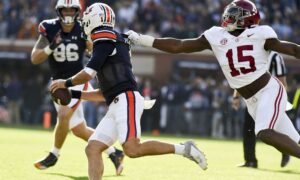Drafting Like the Pros
I have a confession to make. I am not a football scout. I can watch a football game and notice which players are playing at a high level and others that might be struggling. I enjoy watching college games in hopes of finding the stars of tomorrow. I’m even part of the Dynasty Scouts team here at Dynasty League Football, but in the end, I’m no different than most of you when “scouting” players.
This time of year, the majority of dynasty players transform into wannabe NFL scouts, watching clips on DraftBreakdown as their form of grinding tape and taking notes on what they see. There is certainly nothing wrong with this. In fact, I encourage all dynasty players to do as much research as possible and form independent opinions on the incoming rookie class. There are many scouts, professional and amateur alike, that I respect and trust and I use their opinion to help form my own valuation of each future NFL player.
With this overload of information, we often ignore one of the most important pieces of data we have – what NFL teams tell us about players. There is a growing sentiment that dynasty players could be just as successful in rookie drafts by letting the NFL teams make decisions for them, based on the draft capital spent on incoming rookies. I’ve had some discussions on Twitter about this idea with smart people like Adam Harstad and Russell Clay, but wanted to delve deeper into the idea myself.
In some ways, this comparison is apples to oranges. After all, NFL teams are not making every pick with yards from scrimmage and touchdowns as the priority. Blocking, special teams and situational deep threats are all priorities for NFL teams at different portions of the Draft. On the other hand, dynasty owners are making decision based on college production, NFL Combine metrics and team situation. While this can hinder a head-to-head comparison, it has to be considered for those suggesting dynasty players abandon their own evaluations and default to the NFL Draft order.
I began by looking at the past four draft classes and ranking all running backs, wide receivers and tight ends based on their overall NFL Draft position. I chose to leave out the quarterback position from this study since NFL teams and dynasty owners have such a wide and understandable gap in the value of this position. With this data, I hope to find if drafting based simply on NFL Draft order alone could be as successful, or even more fruitful, than the order dynasty players actually chose these rookies. After collecting this NFL Draft information, I gathered rookie dynasty ADP from MyFantasyLeague via Rotoviz for the past four seasons. Here’s what that looks like.
[am4show have=’g1;’ guest_error=’sub_message’ user_error=’sub_message’ ]
Note: Players in italics are not found on both lists. More on them later.
2016:
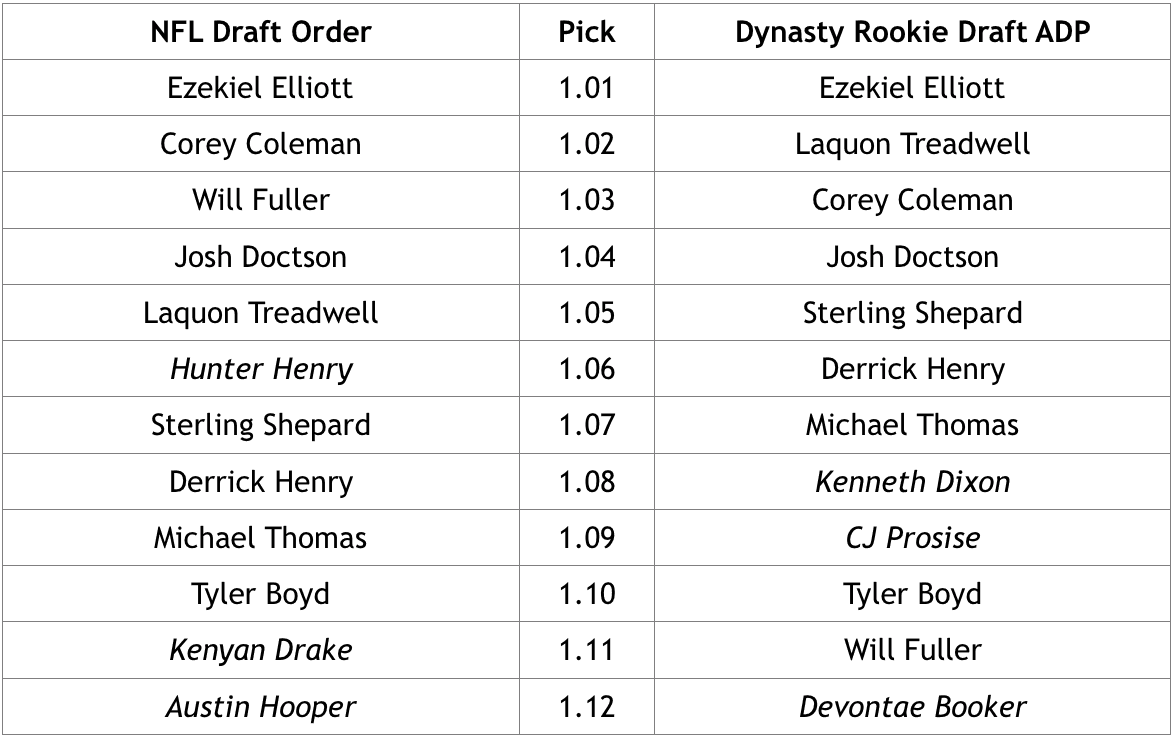
- It is too early to judge most of the players from last year’s class, but Ezekiel Elliott (RB2) and Michael Thomas (WR7) clearly earned their first-round rookie status.
- Most pre-draft rankings had former Ole Miss star Laquon Treadwell as the top wide receiver and although the NFL told us he was the fourth option at the position, dynasty owners still made him the second player off the board.
- One recurring theme you’ll notice from the data is that tight ends rarely crack the first round of dynasty rookie drafts even when the NFL drafts them among the top 12 of fantasy relevant players. This is the case with Chargers rookie Hunter Henry, who had an outstanding year. He’s one player the NFL got right and dynasty owners missed out on, as he fell to the second round of most rookie drafts.
- Although the Dolphins surprisingly made Kenyan Drake the fourth running back drafted, that capital wasn’t enough to push him into the first round of dynasty rookie drafts. In fact, his ADP placed him in the middle of the second round. This is rare as dynasty owners often chase running backs.
- This was the case with CJ Prosise and Devontae Booker, both of who fell outside of the top 12 according to the NFL Draft, but still were routinely drafted in the first round. It is still unclear if this was a wise choice for dynasty owners as each player showed flashes and struggles in their first seasons.
2015:
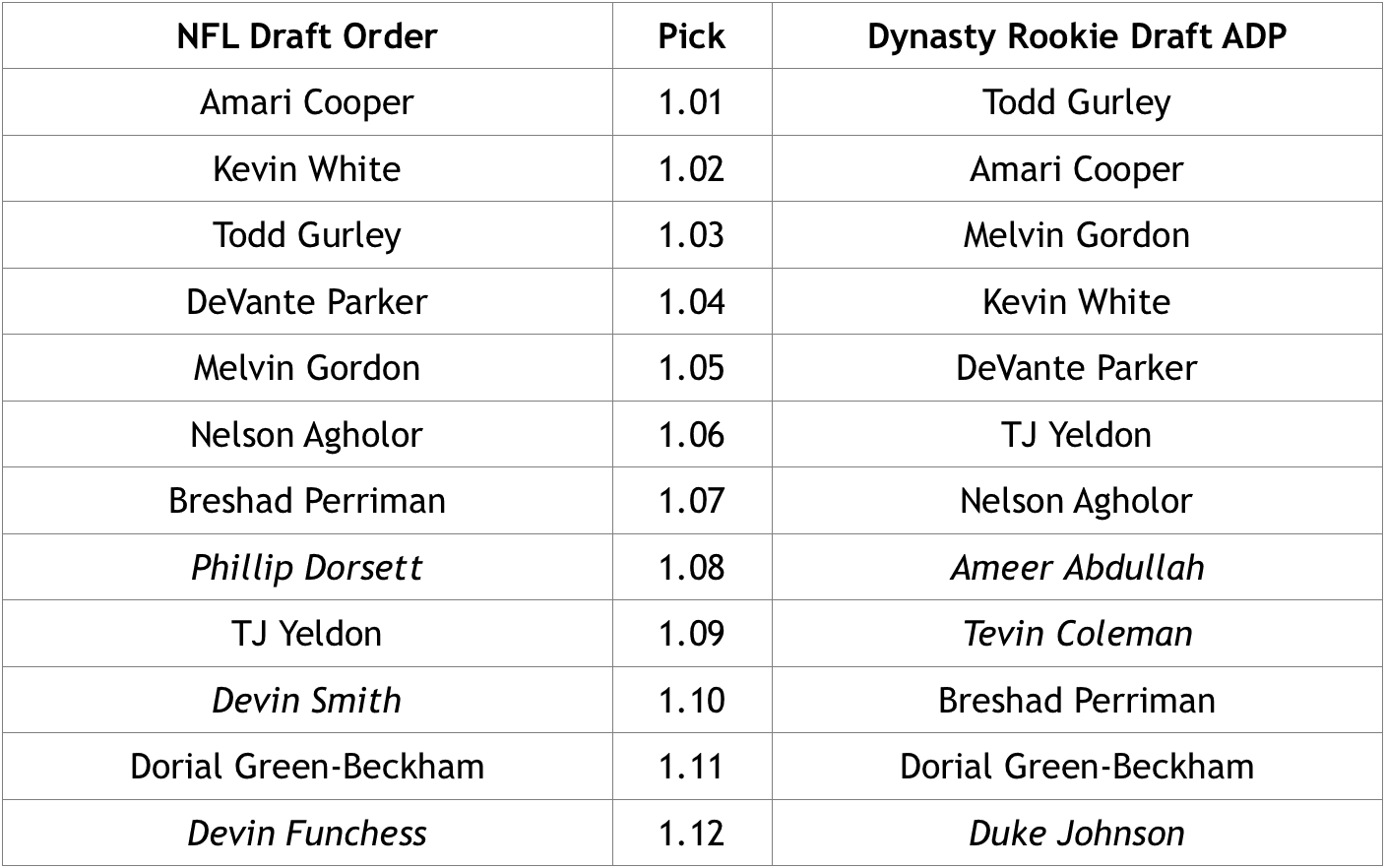
- Dynasty players were chasing running backs once again as Todd Gurley, Melvin Gordon and TJ Yeldon were each taken higher in rookie drafts than their respective order according to the NFL Draft. Also, Ameer Abdullah, Tevin Coleman and Duke Johnson were each deemed worthy of a first-round rookie pick while falling outside of the top 12 in the NFL Draft. I’d say the dynasty players got this one right.
- The inverse was true for wide receivers as each of the eight wideouts drafted among the top 12 were drafted lower in rookie drafts than they were in the NFL Draft. Dynasty owners wisely avoided Phillip Dorsett and Devin Smith, each of whom were drafted earlier than expected in the NFL Draft, yet still fell to the second round of dynasty drafts.
2014:
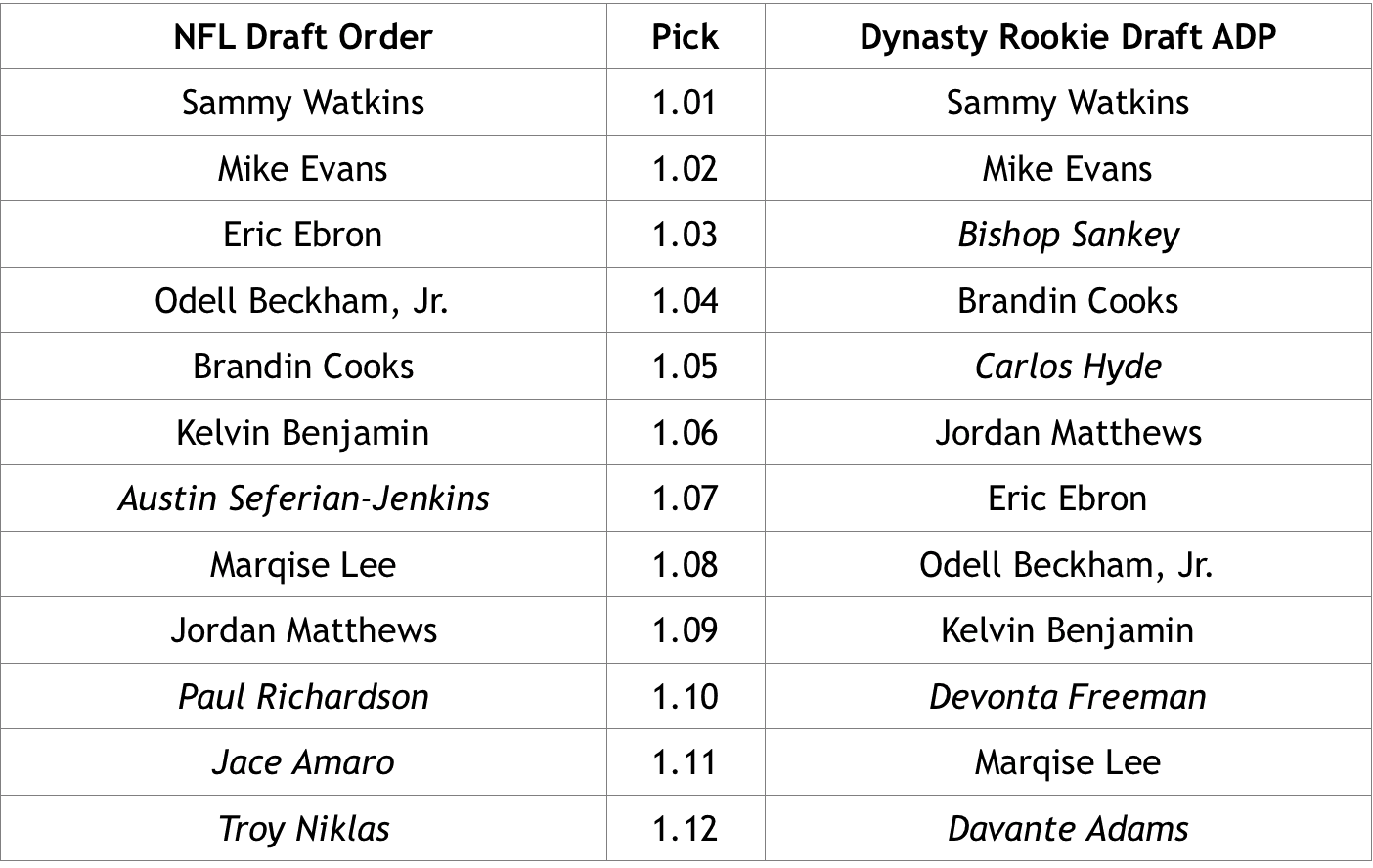
- Again, we see dynasty owners not valuing the tight end spot nearly as high as NFL teams do. While Eric Ebron was still drafted in the first round, Austin Seferian-Jenkins, Jace Amaro and Troy Niklas came off the board much later. Score this as another win for dynasty players.
- Not everything went well for us though, as second rounder Bishop Sankey vaulted from the fourteenth drafted player among the three positions all the way up to the 1.03 rookie pick. I’m sure those who took Sankey over the bevy of top wideouts still feel the sting.
- The Seahawks liked Paul Richardson enough to grab him in the second round, but dynasty owners didn’t trust his slender frame and until a recent hot streak to end the season, they’ve been proven correct.
- The two players who dynasty owners did peg as worthy of a first round selection who also fell outside of the NFL’s top 12 were Davante Adams and Devonta Freeman. More wins for the dynasty crew!
2013:
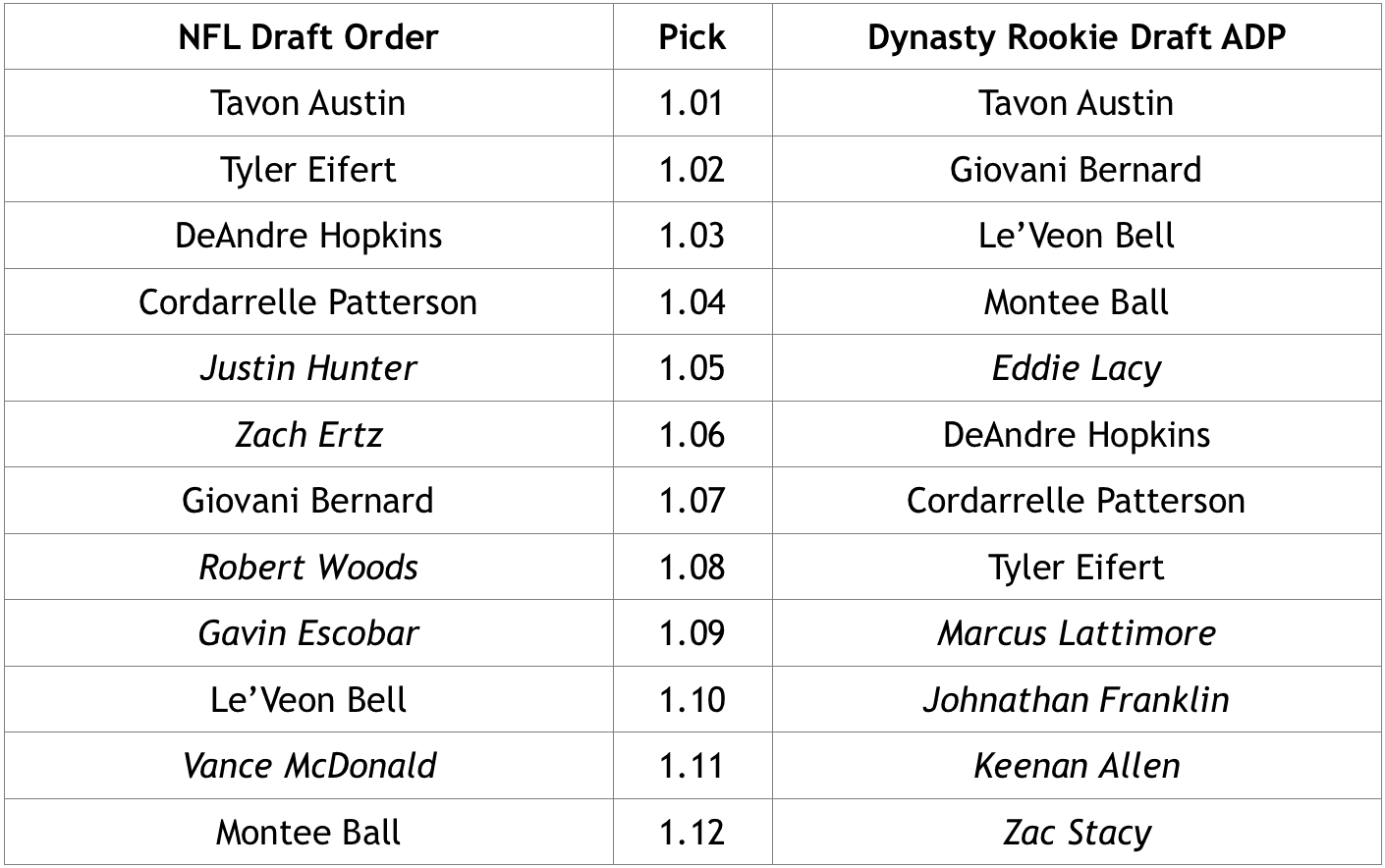
- Our last set of draft data features one of the worst rookie classes in recent memory, with Rams receiver Tavon Austin holding down the 1.01 rookie spot as well as being the first skill position player off the board.
- This group includes more chasing of running backs, with mixed results. Giovani Bernard, Le’Veon Bell and Montee Ball leap into the top four of dynasty rookie drafts. Of course, Bell has proved to be one of the top backs in the game, Ball was a massive bust and Bernard has been somewhere in between.
- Yet again, dynasty owners failed to chase the tight ends drafted early by NFL teams, including Zach Ertz, Gavin Escobar and Vance McDonald. While Ertz has established himself as a top ten dynasty option at the position, all in all, this proved to be another wise choice.
- Even though dynasty owners experienced a pair of misses in the injury-shortened careers of Marcus Lattimore and Johnathan Franklin, elevating Eddie Lacy and Keenan Allen into the first-round range more than makes up for the sting.
Outliers
In each of the four years of draft data listed above, there are players that the NFL and dynasty players disagreed on when making their draft choices. Let’s take a look at which set of players were more productive. While the NFL and fantasy owners judge production in different ways, we’ll continue to focus on the fantasy football side of things, using startable performances as the barometer for success. In this exercise, I used a standard fantasy starting lineup of two running backs, three wide receivers and one tight end and found how many startable seasons each player had produced.
The 15 players chosen among the top 12 by the NFL over that time period have combined for just two startable seasons in a possible 41 seasons played. That means this group of players that NFL teams deemed worthy of a first or second round pick in most cases, managed a startable worthy fantasy season in less than five percent of their opportunity. Both of those are TE1 seasons produced by Zach Ertz.
Let’s compare that to the 15 players dynasty owners opted for instead. This group has combined for ten startable seasons, including a pair of RB1 seasons for Freeman and Lacy and a breakout WR1 season this year for Adams. Even the players who have yet to produce a start-worthy season, such as Ameer Abdullah and Kenneth Dixon still carry plenty of dynasty value, which is not the case for most of the NFL draftees.
I will admit the NFL’s window for success using this metric is limited considering the number of tight ends they drafted as compared to the running backs subbed in by dynasty players. While this slants in favor of dynasty owners, it is also part of the process and must be considered when deciding if we can fully rely on NFL teams when making rookie draft picks.
Conclusions
Remember, I chose to ignore the quarterback position because of the clear delta in value from the NFL to dynasty leagues. This exercise showed me perhaps I should’ve also ignored the tight end spot. In four years, there were ten tight ends chosen among the top 12 players (RB/WR/TE) in the NFL Draft, yet only two of those went on to be chosen in the first round of dynasty rookie drafts.
Judging by the players that don’t overlap on each respective list, the dynasty owners are looking like a smart group. Avoiding the tight ends in general, along with players who were overdrafted based on pre-draft expectations (Dorsett, Drake and Devin Smith among others) led to dynasty owners instead selecting player like Lacy, Allen, Dixon and Freeman, who are all valuable dynasty assets.
I mentioned at the beginning that I was trying to answer the question regarding who does a better job of drafting. Based on just this limited data of the top 12 players in each draft, that distinction has to go to the fantasy footballers over those coaches and general managers who get paid to run teams. Unfortunately, this does not mean we all should have a front office job or current decision makers should be sent packing. There are many reasons for the differential. First, many of the decisions being made by dynasty owners are made based on situation, which NFL teams are stuck in the middle of. We can avoid the Browns second-round wideouts. The Browns can’t. Also, NFL teams are drafting players with a variety of tasks or roles in mind. While an NFL team might select a wide receiver in part due to his blocking ability, fantasy owners are looking only for statistical production.
In the upcoming follow-up to this initial article, I will dig deeper into each position to continue to search for trends while comparing the NFL and dynasty decision makers.
[/am4show]
- Monday Mocks: Expert 2024 Rookie Mock Draft - April 22, 2024
- Monday Mocks: 2024 Landing Spots - April 15, 2024
- Five Landing Spots That Would Tank Rookie WR Value - April 13, 2024






